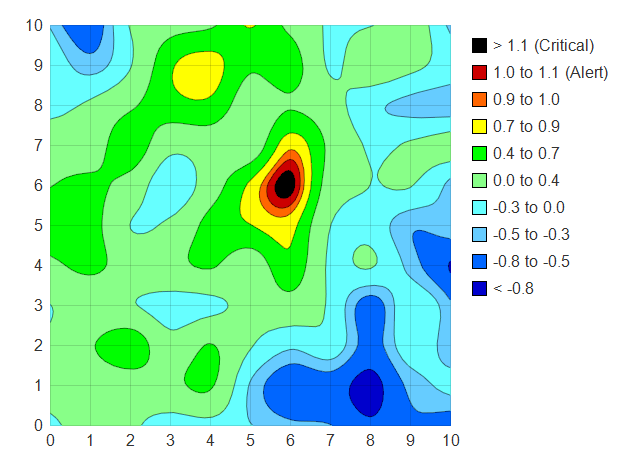
This example demonstrates using a legend box to display the color legend, which is useful for irregularly spaced color scale or for long color labels.
Many of the examples in the documentation uses
ColorAxis to both define and display the color scale. This is useful for evenly spaced contours, which are associated with the ticks and labels on the color axis. If the contours are highly uneven (such as at 0, 1, 2, 50, 195, 200), the labels are also unevenly spaced on the color axis, and some labels may become so close together that they overlap.
This example demonstrates an alternative method of using a
LegendBox to display color legends. The color axis still defines the color scale, but it is not displayed
[File: phpdemo/contourlegend.php]
<?php
require_once("../lib/phpchartdir.php");
# The x and y coordinates of the grid
$dataX = array(0, 1, 2, 3, 4, 5, 6, 7, 8, 9, 10);
$dataY = array(0, 1, 2, 3, 4, 5, 6, 7, 8, 9, 10);
# Use random numbers for the z values on the XY grid
$r = new RanSeries(999);
$dataZ = $r->get2DSeries(count($dataX), count($dataY), -0.9, 1.15);
# Create a XYChart object of size 640 x 460 pixels
$c = new XYChart(640, 460);
# Set the plotarea at (30, 25) and of size 400 x 400 pixels. Use semi-transparent grey (0xdd000000)
# horizontal and vertical grid lines
$c->setPlotArea(50, 25, 400, 400, -1, -1, Transparent, 0xdd000000, -1);
# Set the x and y axis stems to transparent and the label font to 12pt Arial
$c->xAxis->setColors(Transparent);
$c->yAxis->setColors(Transparent);
$c->xAxis->setLabelStyle("Arial", 12);
$c->yAxis->setLabelStyle("Arial", 12);
# Set the x-axis and y-axis scale
$c->xAxis->setLinearScale(0, 10, 1);
$c->yAxis->setLinearScale(0, 10, 1);
# Add a contour layer using the given data
$layer = $c->addContourLayer($dataX, $dataY, $dataZ);
# Move the grid lines in front of the contour layer
$c->getPlotArea()->moveGridBefore($layer);
# Define the color scale
$colorScale = array(-0.8, 0x0066ff, -0.5, 0x66ccff, -0.3, 0x66ffff, 0, 0x88ff88, 0.4, 0x00ff00, 0.7,
0xffff00, 0.9, 0xff6600, 1.0, 0xcc0000, 1.1);
# Apply the color scale, and specify the underflow and overflow colors for regions exceeding the
# color scale
$layer->colorAxis->setColorScale($colorScale, 0x0000cc, 0x000000);
#
# Instead of displaying the color axis, we use a legend box to display the colors. This is useful
# for colors that are unevenly spaced on the color axis.
#
# Add a legend box at (460, 25) with vertical layout, with 12pt Arial font, transparent background
# and border, icon size of 15 x 15 pixels, and line spacing of 8 pixels.
$b = $c->addLegend(460, 25, true, "Arial", 12);
$b->setBackground(Transparent, Transparent);
$b->setKeySize(15, 15);
$b->setKeySpacing(0, 8);
# Add the legend box entries
$b->addKey("> 1.1 (Critical)", 0x000000);
$b->addKey("1.0 to 1.1 (Alert)", 0xcc0000);
$b->addKey("0.9 to 1.0", 0xff6600);
$b->addKey("0.7 to 0.9", 0xffff00);
$b->addKey("0.4 to 0.7", 0x00ff00);
$b->addKey("0.0 to 0.4", 0x88ff88);
$b->addKey("-0.3 to 0.0", 0x66ffff);
$b->addKey("-0.5 to -0.3", 0x66ccff);
$b->addKey("-0.8 to -0.5", 0x0066ff);
$b->addKey("< -0.8", 0x0000cc);
# Output the chart
$viewer = new WebChartViewer("chart1");
$viewer->setChart($c, SVG);
# Include tool tip for the chart
$viewer->setImageMap($c->getHTMLImageMap("", "",
"title='<*cdml*>X: {x|2}<*br*>Y: {y|2}<*br*>Z: {z|2}'"));
# Output Javascript chart model to support contour chart tooltips
$viewer->setChartModel($c->getJsChartModel());
?>
<!DOCTYPE html>
<html>
<head>
<title>Contour Color Legend</title>
<!-- Include ChartDirector Javascript Library to support chart interactions -->
<script type="text/javascript" src="cdjcv.js"></script>
</head>
<body style="margin:5px 0px 0px 5px">
<div style="font:bold 18pt verdana;">
Contour Color Legend
</div>
<hr style="border:solid 1px #000080; background:#000080" />
<div style="font:10pt verdana; margin-bottom:1.5em">
<a href="viewsource.php?file=<?=basename(__FILE__)?>">View Chart Source Code</a>
</div>
<!-- ****** Here is the chart image ****** -->
<?php echo $viewer->renderHTML(); ?>
</body>
</html>
© 2022 Advanced Software Engineering Limited. All rights reserved.
